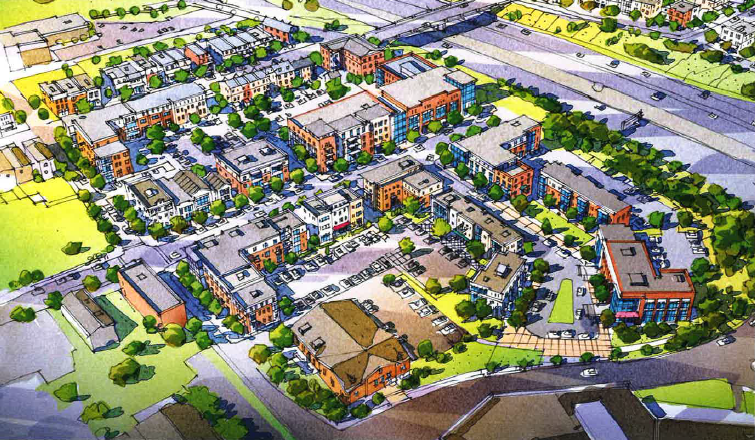
and not this?

To find the answer to this, we would first have to go the year 1913, the year when Henry Ford created the world's first assembly line. The Ford assembly line was an ingenious process that shook the world. Now, people could produce goods at a fastest rate ever in human history. And for years, the assembly line model was being applied to everything, and proved effective especially in restaurants (like McDonalds).
So why not apply this model to building houses?
In 1947, a company called Levitt and Sons (ran by Alfred, William, and Abraham Levitt) purchased a tract of land in Nassau County, NY. And the first Levittown was born. Each construction worker was employed to do one task specifically and do it for every house. This made them easily replaceable (much like unskilled factory workers/fast food workers) and thus made it very hard for them to unionize. It was very cheap to build the same house over and over: you don't need a variety of materials, and you can buy materials in bulk. The savings added up. This method proved to be effective, and to this day many American suburbs are constructed like the original Levittown was 72 years ago.
They also used Rockefeller like tactics such as vertical integration, where they controlled the entire supply chain. They'd own the the lumber company, the nail company, the cement company, etc., or source their products from only one place. It was a huge success, so successful that several more Levittowns were made in NJ, PA, and Puerto Rico. Many of the homebuyers were veterans returning home from the war. The GI Bill made it easy to get a home loan or rent a house. And a house that was affordable and in a quiet, safe neighborhood perfect for raising a family seemed like a dream come true.These neighborhoods were safe and had large, well-funded, newly built schools. People could now live in the safe, peaceful bubbles that they desired so much after years of war. Millions left the inner city to escape the pollution, crime, and - Black People?!
It is said that the period Levittown because the largest homogenous community in the U.S- all 70,000 of its residents were White. "If we sell one house to a Negro family, then 90 to 95 percent of our white customers will not buy into the community. That is their attitude, not ours. We did not create it, and we cannot cure it.", stated William. For this reason, Levitt and Sons did not sell their homes to African Americans. Coupled with the racist housing policies known as redlining, Black people were completely shut out of these suburbs. One line in their lease policy stated "the tenant agrees not to permit the premises to be sued or occupied by any other person other than members of the Caucasian race." However, they could not legally prevent existing homeowners from reselling to Black Buyers. In 1957, William and Daisy Myers, a Black couple with young children, became the first African American family in Levittown, PA. They were met with intense, almost never-ending hostility, and received threats of violence almost daily. However they they stood their ground, and persevered through the hate with dignity and courage, and eventually filing criminal charges against the worst members of the mob.
However, in the meantime, the State of New Jersey had passed a law against housing discrimination. William Levitt realized that sooner or later, he would have to comply with this law. He made an integration program, and appointed Harold Lett, an African American who served in NJ's civil rights division, to run it. Salesman would show Black families the most desirable homes in the subdivision. And surprisingly for that time, the White families around them accepted them. On the day he moved , Willie R. James (a Black man) came home to find a White neighbor helping his wife hang the curtains.
The Levitt & Sons company's vast tract housing projects changed lives. They became the symbol of the American Dream: owning an independent house and the land that was on it. Of course, the houses of Levittown don't look all the same anymore. The people that moved in have long since renovated them to look different from each other. Levittowns transformed how we live in the same way fast food changed how we eat. They popularized an iconic way of American living. Millions live happily in the suburbs - it's a great place to live and raise a family. Though many millenials are choosing to move into revived inner city centers, tract-housing will remain popular for years to come.
Sources:
https://home.howstuffworks.com/home-improvement/construction/planning/why-cookie-cutter-neighborhoods-exist1.htm
https://historyengine.richmond.edu/episodes/view/5272
https://www.aclu-nj.org/about/50thanniversary/on-the-frontlines-of-freedom/on-the-frontlines-of-freedom-chapter-one-1
I found your article about Levittown to be very interesting, yet sad because of the discrimination there was towards black people. The idea of segregating and denying families housing just for profit must have caused families to feel terrible. Even though that type of discrimination isn't allowed, not much has changed in Levittown. According to the 1990 census, over 97% of the residents of Levittown are white. It's sad to see that the Levittown seems to be holding on to a legacy of racism, but hopefully that will change one day.
ReplyDeleteSource: https://www.nytimes.com/1997/12/28/nyregion/at-50-levittown-contends-with-its-legacy-of-bias.html
This was a very interesting article. I like how you gave a brief history of Levittowns and how other industries influenced it. I think it is important that you also included the cultural implications and affects these towns had on the the distribution of blacks and whites throughout communities.
ReplyDelete